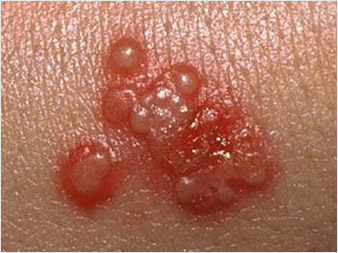Genital herpes
 Genital herpes is a frequent and recurrent infection. Herpes is caused by a virus of which there are two types: HSV-1 and HSV-2. 98-99% of cold sores are caused by HSV-1. Genital herpes is associated with HSV-2 in 70% of the cases and HSV-1 in about 30%. Approximately 25% of the sexually active adult population is infected with herpes simplex type 2 (HSV-2).
Genital herpes is a frequent and recurrent infection. Herpes is caused by a virus of which there are two types: HSV-1 and HSV-2. 98-99% of cold sores are caused by HSV-1. Genital herpes is associated with HSV-2 in 70% of the cases and HSV-1 in about 30%. Approximately 25% of the sexually active adult population is infected with herpes simplex type 2 (HSV-2).
HSV are transmitted by direct skin-to-skin contact or through contaminated genital secretions. Symptoms may arise 2-20 days after the initial exposure. Many studies have shown that the majority of affected individuals are not aware of it.
The risks of transmission of HSV viruses are greatest in the 12-24 hours period following the appearance of skin lesions and until all the lesions are completely dry. The risk of transmission decreases in the absence of lesions although it is always present.
The most common symptoms include an initial sensation of malaise in the affected area followed by the appearance of one or more blisters. The blisters break and leave painful sores. A recurrent episode may last a week or so. The first time an individual has an outbreak he may also experience flu-like symptoms such as fever, body aches and swollen glands.
A doctor can sample fluid from a fresh lesion to confirm the diagnosis and to identify the HSV subtype. Sometimes a special blood test consisting of a differential serology can be done to confirm the presence of HSV and help determine the subtype.
Commonly offered STD (STI) screenings do not routinely include HSV screening.
For HSV culture, HSV differential serology or for a more complete STD (STI) screening, make an appointment or contact the private medical clinic Crea-MeD at 514‑345‑1356 or email info@crea‑med.ca